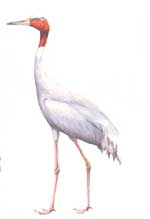By Dr. Susan Sharma
Schedule I, Part III of the Indian Wildlife (Protection) Act, 1972 lists rare and endangered birds which are totally protected throughout the country, live or dead or part thereof. They include Andaman Teal, Assam Bamboo Partridge, Bazas, Bengal Florican, Blacknecked
Crane, Blood Pheasants, , Eastern White Stork, Forest spotted owlet, Jerdon's Courser, Cheer Pheasant, Great Pied Hornbill, Hawks, Great Indian Bustard, Hooded Crane, Hornbills, Houbara Bustard, Humes Bartailed Pheasant, Indian Pied Hornbill, Lammergeier,
Large Falcons, Large Whistling Teal, Monal pheasant, Mountain Quail, Narcondam Hornbill, Nicobar Megapode, Nicobar Pigeon, Osprey, Peacock-Pheasant, Peafowl or Indian Peafowl, Pinkheaded Duck, Scalter's Monal Pheasant, Siberian White Crane, Tibetan Snowcock,
Tragopan-Pheasant, Whitebellied Sea Eagle, White-eared Pheasant, White Spoonbill, and Whitewinged Wood Duck.

The Sarus Crane ( Grus a.antigone)
The sarus crane is an endangered species found largely in the Indian wetland habitats. The Wildlife Institute of India conducted a study in 1998, on the impact of land use changes on the habitat and ecology of the Indian Sarus
Crane. The Project documented at least 20 nesting sites of Sarus cranes along the irrigation canal system created wetlands and agricultural land in and around Kota ( Rajasthan) city. It was found that high proportions of these unprotected nests were destroyed
by village urchins. A series of awareness campaigns were conducted during 1998-2002 to make the villagers aware of the plight of the Sarus crane. The Indian Bird Conservation Network and Wildlife Trust of India jointly helped create the "Rural Village Sarus
Protection Group" with full support from local NGOs.